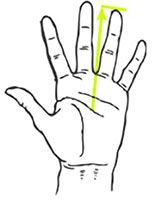Grip and String Information
Grip Size
1. Hold your playing hand flat, palm side up.
2. Record the distance from the middle crease of your palm, up to the top of your ring finger. Choose a grip size closest to your measurement.
Adult grip sizes are between 4-1/8" and 4-5/8"
Junior grip sizes are usually between a 3" and 4-1/8" grip.
If you are between grip sizes choose the smaller grip and add an overgrip. Overgrips usually add 1/16".

These are the grip sizes that are available:
- USA = Europe
- 4-1/8 = 1
- 4-1/4 = 2
- 4-3/8 = 3
- 4-1/2 = 4
- 4-5/8 = 5
What string should I buy?
With hundreds of strings on the market, it can be overwhelming trying to find the one that best complements your game. But if you take the time to understand the main categories of string and what your priorities are, you'll have an easier time narrowing down the possibilities. There are five categories of string:
Nylon Solid Core (Synthetic Gut): This is the most basic (and least expensive) type of string, with a solid core and one or two outer wraps. These strings are fairly durable and hold tension well, but they aren't the most comfortable because they're relatively stiff and don't cushion much of the ball's impact. Some of the best choices in this category include Wilson Synthetic Gut Power, Gamma Synthetic Gut, and Babolat Synthetic Gut.
Nylon/Polyurethane Multifilament: Multifilaments are composed of hundreds, often thousands, of individual fibers that are woven together to create a uniform piece of string. With multifilaments, you'll get excellent feel and comfort because they do a good job of absorbing shock. Multifilaments usually run from $15 to $30; when you factor in the labor, it's a pricy but worthwhile proposition, especially for better players who like to feel the ball. Our favorites are Wilson NXT Power, Tecnifibre X-One Biphase, and Gamma Live Wire Professional.
Natural Gut: Still the gold standard, natural gut——which is made of cow intestine——pockets the ball more deeply across a smaller area for control and also allows for a greater energy return to the ball for power. You won't more comfortable string, so if you have arm problems, natural gut is, well, the natural choice. However, natural gut is the most expensive, the least durable (players who hit a heavy ball have been known to break a string in a couple hours), and it's the most susceptible to losing tension when exposed to moisture or abrupt temperature changes. Companies do add protective coatings to alleviate these downsides. Babolat, which produces 90 percent of the natural gut on the market, has many types of gut; we like the Babolat VS Touch.
Polyester: These strings are popular among advanced players who find that poly takes a little power off their shots, which enables them to swing harder and still keep the ball in play. Polyester is also ideal for those who tend to break strings but who don't want to use a stiff, uncomfortable Kevlar hybrid. Polyester's biggest weakness is that it loses tension quickly, though the latest generation, of which the Babolat RPM Blast, Luxilon ALU Power, and Solinco Hyper G are among the best, does a better job of maintaining its tension thanks to recent advances in the manufacturing process.
Hybrids: The combination of one type of string for the mains and another for the crosses is called a hybrid. This is done for durability. Frequent string-breakers should go with a stiffer polyester for the mains (the strings that usually break first) and a softer synthetic multifilament for the crosses. Hybrids provide a compromise of durability from the polyester mains strings, with playability from the softer synthetic cross strings. Two of the most popular prepackaged aramid hybrid sets are Wilson NXT Duo Power and Babolat RPM Blast/Xcel. Some higher end hybrids offer a natural gut and polyester combination for a more forgiving feel than synthetic gut based hybrids. Wilson Champions Choice and Babolat RPM Blast/VS Gutare 2 are great options.
What tension should I get?
We have provided the manufacturer's recommended tension range, measured in pounds, for each racquet, but 55 to 65 pounds is a common range. The higher end will provide more control. The lower end will provide more power. Remember, increasing power reduces control and increasing control reduces power. We suggest to find your ideal tension, string your racquet in the middle of your frame's suggested range. After you play a few times, you'll be faced with one of three scenarios:
- You have the ideal amount of control and power. If this is the case, you've found the right tension.
- Your shots are flying and you didn't get enough control. Increase your racquet's string tension by two pounds. You'll lose some depth on your shots, but you'll gain control.
- Your shots don't have enough pop on them. String your racquet at a slightly lower tension. Remember, though, that if you lower the tension too much, the strings will become trampoline-like and you'll have significantly less control.
